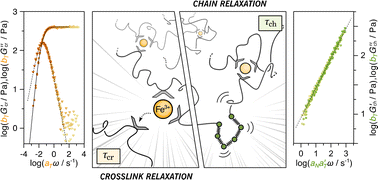Modelling viscoelastic relaxation mechanisms in thermorheologically complex Fe(iii)–poly(acrylic acid) hydrogels†
Abstract
Mechanical properties of hydrogels with reversible transition metal–polymer crosslinks can be flexibly tuned depending on the dissociation kinetics of the metal bond. We use rheology to investigate the sol–gel transition of a Fe(III)–poly(acrylic acid) network with varying crosslinker content and model the corresponding mechanical relaxation at different stages of gelation. The system transitions from an unentangled chain regime to a crosslink dissociation dominated regime, where the relaxation is governed by two timescales with different activation energies. To account for the interplay of chain and crosslinker dynamics, a time–temperature–superposition procedure is introduced for both processes separately, thus separating the dynamic processes in these thermorheologically complex dynamic networks. The activation energy of chain relaxation remains unchanged whether or not the chain participates in the network. To model contributions to the dynamic modulus of each process, we combine concepts from fractional viscoelasticity with a generalized Maxwell model, which describes the dynamics of an unentangled chain solution with reversible crosslinks. This allows us to quantify the evolution of viscoelastic parameters in the course of gelation, where we find that the terminal relaxation time of the gels increases less than expected at high crosslinker contents. This result is attributed to a facilitated crosslink exchange mechanism and a lower pH of the gel matrix.



 Please wait while we load your content...
Please wait while we load your content...